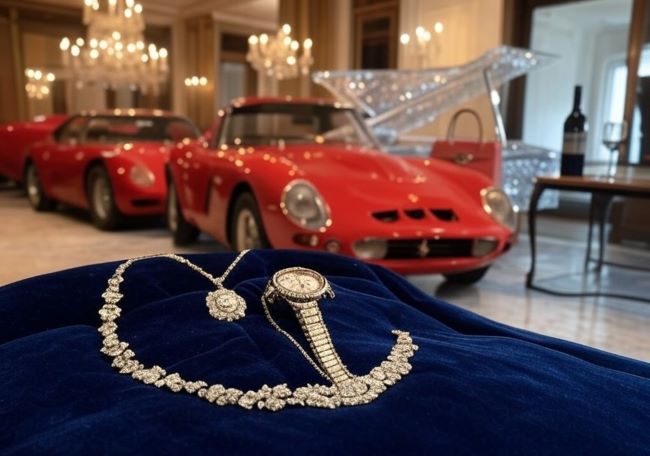From Fine Art to NFTs …
For centuries, the wealthy have sought ways to store and showcase their wealth in ways that are both practical and prestigious. While real estate has long been a preferred choice, it comes with its own challenges—owning multiple properties requires high maintenance, taxation, and logistical oversight. In contrast, art and collectibles provide a more flexible and portable store of wealth. As technology advances, digital assets such as NFTs (Non-Fungible Tokens) are reshaping how wealth is preserved and displayed, leading to a shift in traditional investment and status symbols.
Art and Collectibles as Wealth Storage
The Role of Art in Wealth Preservation
Art has always played a significant role in wealth preservation, spanning classical paintings, sculptures, photography, and digital artwork. The value of art is often subjective, driven by cultural significance, artist reputation, and scarcity. Art movements such as Impressionism, Modernism, and Contemporary Art have influenced how art is perceived and valued.
- Investment Potential: High-profile pieces by renowned artists like Picasso, Warhol, and Basquiat have seen significant appreciation in value over time, making them sound financial investments.
- Status and Social Prestige: Owning famous or expensive artworks elevates social standing, signaling wealth, taste, and cultural sophistication.
- Aesthetic Enjoyment: Many collectors genuinely love art and buy pieces for their beauty and emotional resonance.
- Cultural Philanthropy: Some wealthy individuals buy art to support artists and cultural institutions, often donating pieces to museums for tax benefits and legacy building.
- Asset Diversification: Art serves as a hedge against inflation and economic downturns, as its value does not directly correlate with traditional financial markets.
- Privacy and Safety: Unlike stocks or real estate, art does not always require public disclosure, providing privacy for wealth management.
- Tax Benefits: In some jurisdictions, tax incentives exist for buying and donating art.
- Networking and Business Opportunities: The art world is a hub for social and business networking, where collectors and investors connect at gallery openings, art fairs, and auctions.
- Speculation: Some buyers engage in speculative ventures, purchasing emerging artists’ work in hopes of selling at a higher price later.
Tokenized Art and Fractional Ownership
Recent advancements in technology have introduced tokenization to the art world, allowing investors to buy fractional ownership of high-value paintings. Platforms such as Masterworks and Securitize offer tokenized investments, making fine art accessible to a broader range of investors. This innovation bridges the gap between traditional and digital investments, democratizing access to high-value assets.
Collectibles and Luxury Goods
Beyond art, collectibles such as rare wine collections, vintage cars, and high-end watches function as both investments and social flexes. These assets allow owners to participate in exclusive circles while appreciating in value over time.
The Digital Age: NFTs and Virtual Collectibles
With the rise of blockchain technology, NFTs have emerged as the digital equivalent of fine art and collectibles. While there is ongoing debate about their longevity, NFTs have undeniably changed how wealth is perceived and managed in digital spaces.
NFTs as the Next Status Symbol
Just as traditional collectors seek out works by Monet or Warhol, crypto investors pursue digital assets like CryptoPunks, Bored Apes, and Fidenzas. These digital collectibles serve as cultural markers within online communities, symbolizing early adoption, wealth, and digital scarcity.
Prominent NFT Collections
(not an endorsement or recommendation as per all assets mentioned on the site)
- CryptoPunks: One of the first major NFT projects featuring 10,000 unique characters with distinct features.
- Bored Ape Yacht Club: A collection known for its exclusive membership perks, including events and merchandise.
- Fidenza by Tyler Hobbs: Algorithmically generated digital artwork, ensuring each piece is unique and scarce.
The Scarcity Factor
Just as rare paintings command high prices due to their exclusivity, limited-edition NFTs attract collectors and investors alike. The concept of digital scarcity ensures that certain NFT collections become highly sought after, serving as both an investment and a status flex.
Compounding Wealth in Crypto
Many high-value NFTs are priced in Ethereum (ETH). When ETH appreciates, the value of these NFTs increases exponentially in fiat terms. This dual compounding effect makes them attractive to crypto investors looking for alternative wealth preservation strategies.
The Future of Digital and Physical Wealth Storage
As the world shifts toward digital assets, the desire to own investments that can be easily transferred, displayed, and stored without physical constraints is growing. However, traditional luxury assets will not disappear; rather, they will coexist with digital collectibles.
Hybrid Wealth Storage
A future where high-net-worth individuals own both traditional fine art and NFTs is likely. Some collectors have already begun tokenizing physical assets such as real estate and paintings, creating digital shares of ownership on blockchain platforms.
Metaverse and Virtual Real Estate
Digital land in metaverse platforms like Decentraland and The Sandbox is emerging as a new form of real estate investment. These virtual spaces provide another avenue for wealth storage and social engagement in digital environments.
Exclusive Digital Memberships
NFTs are evolving beyond artwork to serve as gateways to exclusive communities, events, and experiences. Similar to elite social clubs in the physical world, NFT-based memberships grant access to high-value digital experiences and real-world perks.
Conclusion: The Shift in Wealth Display and Investment
Wealth storage is undergoing a transformation. While real estate remains a fundamental asset class, the ultra-wealthy are diversifying their portfolios with fine art, collectibles, and digital assets. The transition from physical to digital wealth storage is well underway, and NFTs represent a significant part of this movement.
The rise of tokenized art has further democratized access to high-value assets, merging traditional and digital investment strategies. As blockchain technology matures, digital ownership will become as legitimate and desirable as owning a rare painting or a luxury property. Whether NFTs will remain a lasting phenomenon or fade as a fad is yet to be determined, but they have undeniably reshaped the landscape of wealth storage and status symbols in the modern era.

